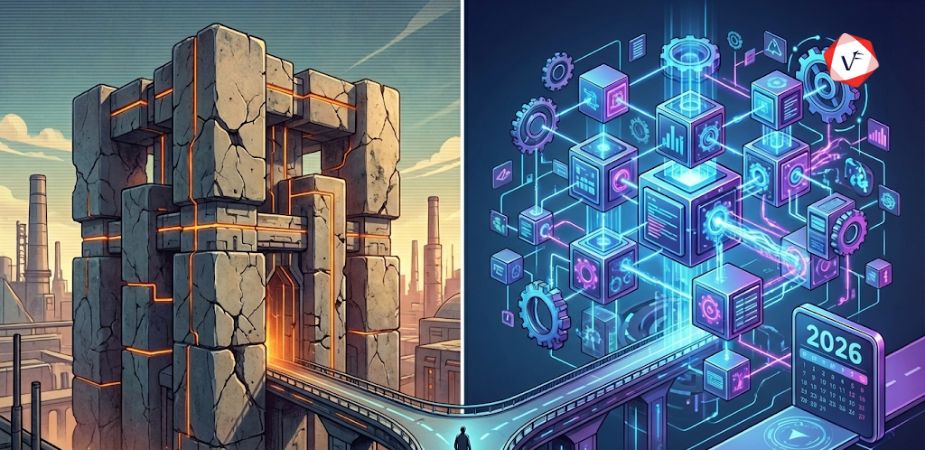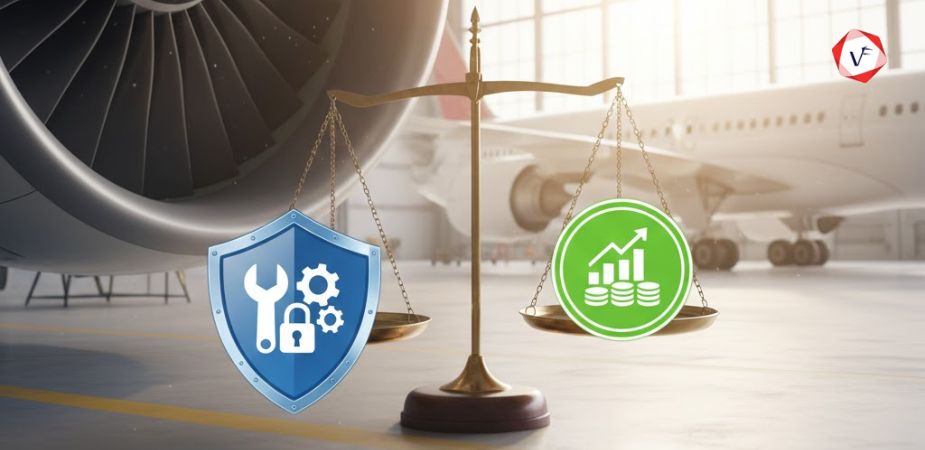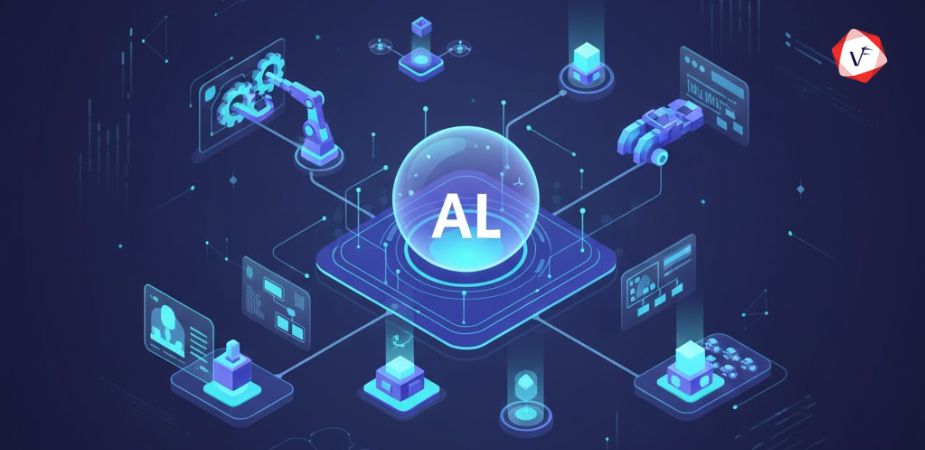In today’s business landscape, IT is a critical component of any organization’s success. However, not all companies have the resources or expertise to manage their IT infrastructure and support their employees’ technology needs. That’s where Managed IT Services and Support, and IT Staff Augmentation come into play.
Managed IT Services And Support
While these two concepts may seem similar at first glance, they are, in fact, different approaches to managing and supporting an organization’s IT needs. In this article, we will explore the differences between managed IT services for business and IT Staff Augmentation services, and how each can benefit your organization. By the end of this article, you will have a better understanding of which approach is right for your business.
The method of administering an organization’s IT operations to a third party is known as managed IT services. These knowledgeable outside companies are in charge of managing the company’s whole IT infrastructure. They offer a variety of services, including security, data backups, round-the-clock monitoring, and on-demand help. Additionally, some businesses demand that MSPs supply them with hardware, including servers, networks, PCs, and storage systems.
How Do They Work?
Managed IT Services and support typically work as follows:
- Assessment: The managed IT service provider (MSP) assesses the client’s IT infrastructure, processes, and needs to develop a tailored service plan.
- Agreement: The MSP and client agree on a service-level agreement (SLA) that outlines the services to be provided, the pricing structure, and the terms of the agreement.
- Implementation: The MSP implements the services agreed upon in the SLA, such as continuous monitoring and management of the client’s IT infrastructure, help desk support, security management, and data backup and recovery.
- Maintenance and Support: The MSP continuously maintains and supports the client’s IT infrastructure and applications, including updates, patches, and troubleshooting. The MSP may also provide proactive recommendations for improving the client’s IT infrastructure and processes.
- Reporting and Communication: The MSP provides regular reports and communicates with the client to ensure that they are aware of any issues or changes in their IT infrastructure and are satisfied with the services provided.
- Scalability: As the client’s IT needs change, the MSP can scale their services up or down accordingly to ensure that the client is receiving the appropriate level of support.
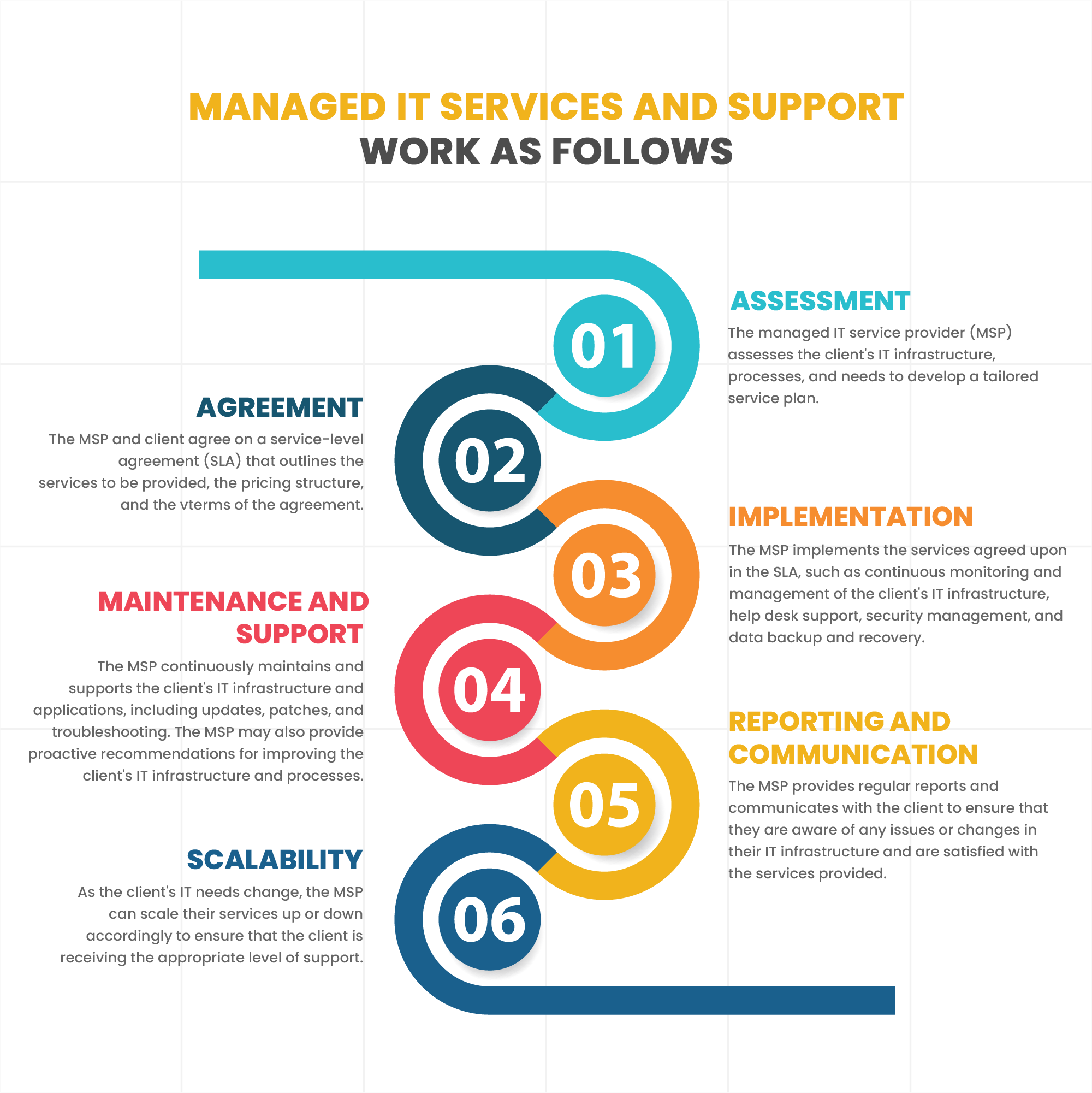
Image showing the process of managed IT services, including assessment, agreement, implementation, maintenance and support, reporting and communication, and scalability.
IT Staff Augmentation
IT staff augmentation is a common practice for organizations that require additional expertise to complete projects. It involves temporarily hiring IT consultants or professionals to bolster a team’s capacity and address short-term workload demands. The individuals engaged in these projects are compensated hourly and depart once their work is finished. When partnering with an IT services provider, organizations frequently hire the entire team to ensure seamless collaboration and achieve project goals efficiently. The quality of the staff augmentation process is critical for organizations to achieve their desired outcomes while maintaining operational excellence.
How Does It Work?
IT staff augmentation services typically works as follows:
- Identification of Needs: The managed IT service provider (MSP) assesses the client’s IT infrastructure, processes, and needs to develop a tailored service plan.
- Selection of Resources: The client works with an IT staff augmentation company to identify and select the appropriate resources with the necessary skills and experience to meet their needs. The client may choose to hire an individual or a team of IT professionals.
- Onboarding and Training: The selected IT professionals are onboarded to the client’s team, and they receive training on the client’s procedures, policies, and working methods to ensure a smooth integration into the client’s environment.
- Integration and Work: The IT professionals integrate into the client’s team and work together to accomplish the project or workload assigned to them. They may work remotely or onsite at the client’s location.
- Supervision and Management: The client supervises and manages the IT professionals’ work, ensuring that the project stays on schedule, meets quality standards, and that the IT professionals meet their roles and responsibilities.
- Payment: The client pays the IT staff augmentation company or the services provided by the IT professionals, usually on a monthly or per-project basis.
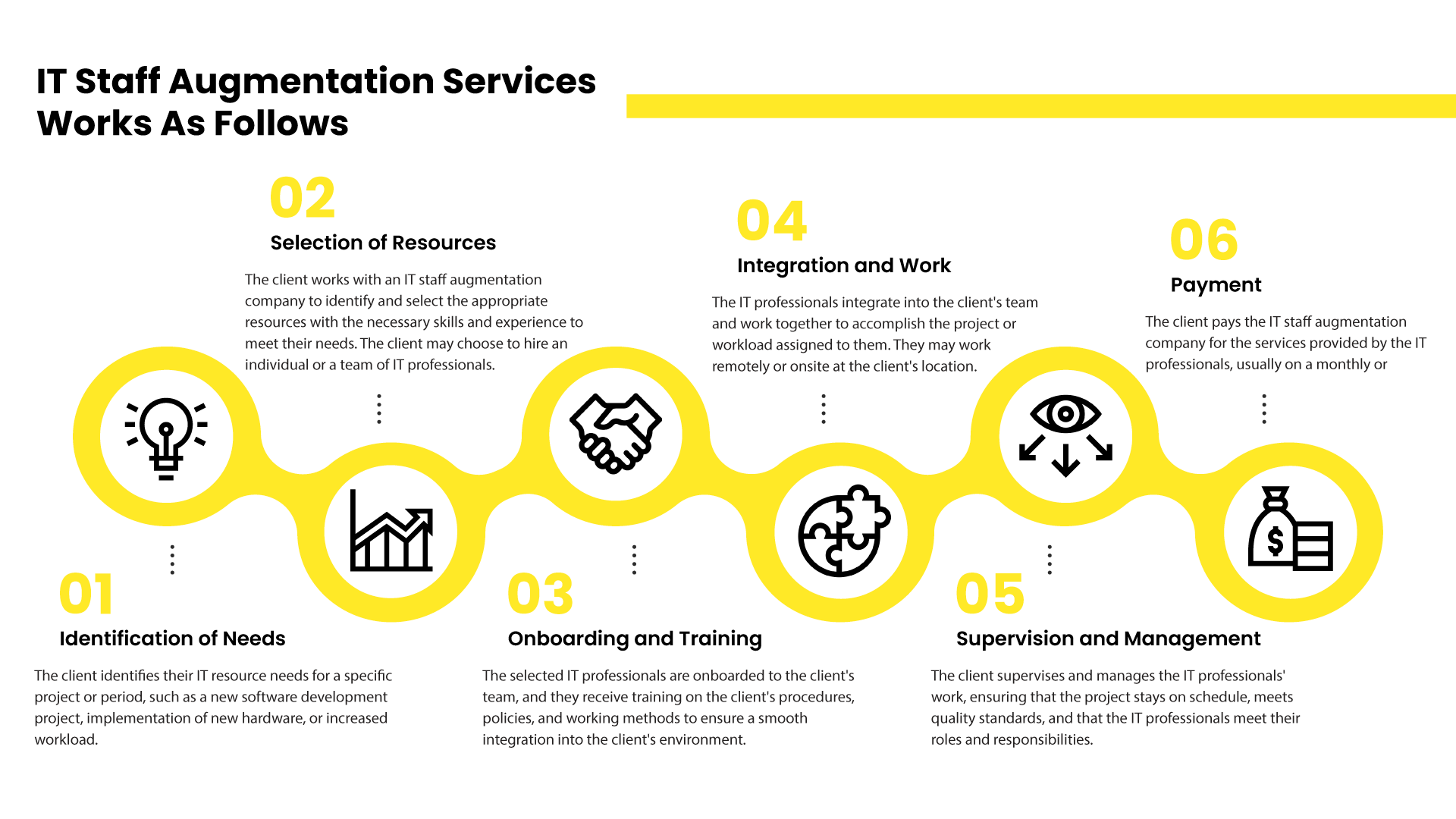
Read more about how to extend your team using Staff Augmentation
Managed IT Services And Support Or IT Staff Augmentation For Your Business?
The table below highlights the key differences between IT Staff Augmentation and Managed IT Services and support, including the cost, focus, training, and pricing structures. Organizations must carefully consider their specific IT needs and project goals when choosing between these two options to ensure that they select the one that best meets their requirements.
| Managed IT Services & Support | IT Staff Augmentation Services | |
|---|---|---|
| Cost | Generally more expensive than staff augmentation services | Generally less expensive than managed IT services |
| Focus | Focused on completing specific tasks as per instructions | Focused on overall goals of the function |
| Training | MSP provided staff with training | Recruited staff receives training on client procedures and working methods |
| Pricing | Based on the number of hired employees and their working hours | Charged monthly or per project for a set amount of time |
Which Model Suits You Best?
Instead of making a choice, think about the use case. Knowing the essential distinction between the two models, you should examine it through the perspective of five main factors:
- Project Scope
- Budget
- Control
- Infrastructure And Network Structure
- Specific IT Expertise
Managed IT Services & Staff Augmentation With Vofox
Vofox’s staff augmentation and managed IT services make it possible for you to locate skilled and experienced professionals who can confidently fit into your team. They can work hand in hand with your on-site or remote staff to meet your specific business requirements. Our committed workforce will oversee the timely accomplishment of your objectives as you concentrate on the wider picture.
Visit us at www.vofox.com
Final Thoughts
The two most widely used models for software development outsourcing at the present time are managed IT services and support and staff augmentation. Each has unique benefits, drawbacks, and concerns. Staff augmentation is simply the best option if you require additional authority and accountability and have the resources necessary to lead a development team. Otherwise, managed services are the best option if you want to hand off all of the work to a development firm. We as a reputable managed IT and IT staffing agency, offer you a proven, trusted, and reasonable method of effectively expanding the size and productivity of your internal development team.
FAQs
1. How Much Do Managed Services And Staff Augmentation Cost In India?
The price of staff augmentation services in India varies depending on your organizational requirements. Prices for staff augmentation can be determined using developers’ average pay. Typically, this falls between $25 to $50 per hour. However, the price of managed IT services will be influenced by the knowledge and experience of developers. On a turnkey basis, this can be paid hourly or given a project cost.
2. Why Is Staff Augmentation Necessary?
Businesses frequently have a shortage of resources, which extends the turnaround time. Although hiring permanent personnel may be effective, the costs associated with hiring and training them to rise even when they are not actively working on any projects.
3. Why Choose Managed Services?
Managed Service Providers (MSPs) are external organizations that provide support and maintenance for businesses’ IT requirements. Because of this, modern enterprises frequently view managed IT services as a simple remedy to shifting demands.



